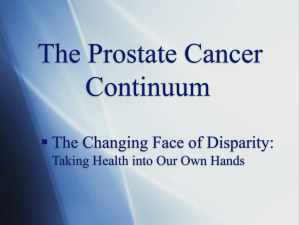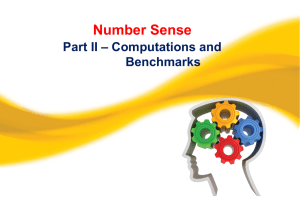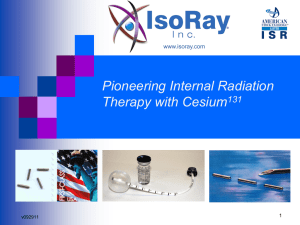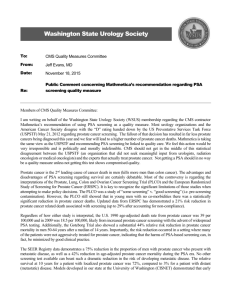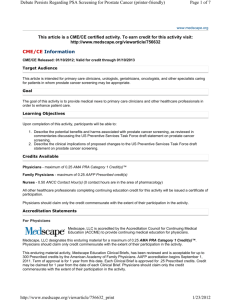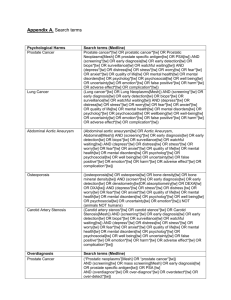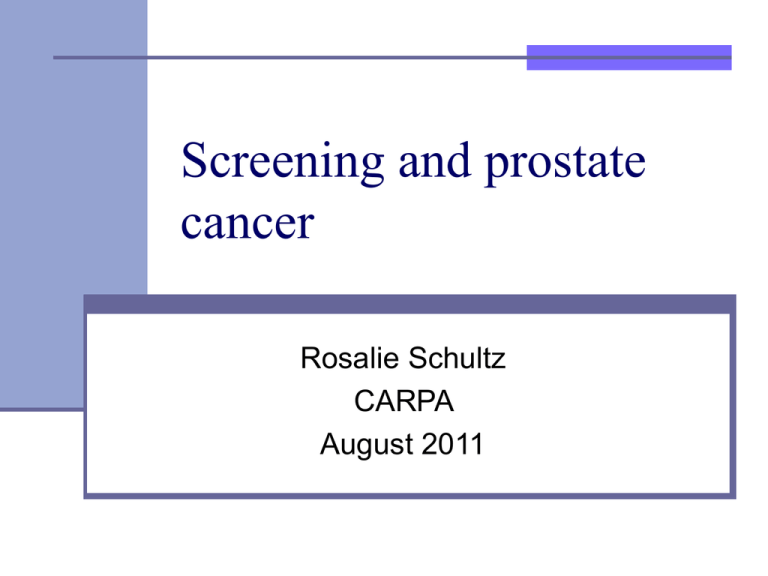
Screening and prostate
cancer
Rosalie Schultz
CARPA
August 2011
Screening
What is disease screening?
High risk
Low risk
Benefits from disease screening
Early diagnosis so the disease can be treated
more effectively
More people cured
Lives saved
Harms from disease screening
Inconvenience
Anxiety
Wrong test results
Unnecessary treatment
False reassurance
What diseases to screen?
What diseases to screen?
Disease screening
Disease must have early stage
Suitable test – finds people at risk
Effective treatment for people with disease
Screening program must reduce sickness and death
Benefits must be greater than harms, physical and
psychological
Social and ethical issues
Costs should be less than benefits
Screening for cancer in Australia
Cervical cancer
Breast cancer
Bowel cancer
Cervical cancer screening
All women age 18 to 70 who have ever had sex
2nd yearly pap smear tests
Detects abnormal cells in cervix (“opening of the
baby bag”)
Abnormalities may resolve without treatment
Some abnormalities later become cancer - 10 years
Minor operation can remove abnormalities, prevent
cancer
About 65% of Australian women have pap smears
Cervical cancer screening
Breast cancer screening
Women aged 50 to 69
Mammography – special x-ray of the breasts
Detects abnormalities that cannot be felt
Small operation can find out if abnormality is
cancer
Many cancers detected by screening would
never cause sickness – 25-30%
About 10 women are treated for every one
who benefits
About 55% of women have mammography
Breast cancer screening
Bowel cancer screening – 2006-2008
50, 55 and 65 year-olds invited to send in
specimen (1 000 000 Australians)
39% had test
7.5% positive = 29 000
5.2% had cancer = 1500
41% no cancer or adenoma = 12 000
Full results awaited
Prostate
Male deaths from cancer Australia 2007
Cancer
% of all
deaths
Mean age
at death
Lung
Number of
deaths
4700
6.7
72
Prostate
2900
4.2
80
Colon
1300
1.8
73
Pancreas
1200
1.7
71
Rectum
900
1.3
71
Prostate cancer in Australia
Breast and Prostate cancer in Australia
Prostate cancer in NT
Per 100 000 Territorians, Aged standardised, 1991-2005
Death in Australia from prostate
cancer 2007
Age group
Number of deaths Rate per 100 000
<40
0
0
40-44
45-49
50-54
55-59
3
7
18
55
0.4
0.9
2.6
8.7
60-64
70-74
75-79
142
315
567
26.6
101.1
223.1
80-84
85+
713
903
413.8
800.9
Prostate cancer screening?
Slow growing disease
Tests:
PSA (prostate specific antigen) blood test
Digital rectal examination – may find extra cases
Treatment – surgery, radiotherapy, chemotherapy
40% impotence
3% incontinence
Number who would benefit 0.1%
Autopsies show prostate cancer in 10-20% of 50 year
old men; 40-50% of 70 year old men
Prostate cancer screening
Many false positive results
Unpleasant follow-up diagnostic procedures
Aggressive treatments
Disease may never have symptoms
Benefit to few and costs to many
Harmful effects greater than health gain from
detecting true cases of prostate cancer
No official screening program
50% of Australian men have been tested
Prostate cancer screening
Prostate cancer screening decreases
prostate cancer mortality
Large increase in people diagnosed and
treated (overtreatment).
Severe side-effects of treatment
Many men have symptoms from surgery,
radiotherapy and chemotherapy
Few men live longer or better
Balance is health loss with increased costs
Live long enough to die from prostate cancer
Thank you!
Male deaths from cancer Australia 2007
Cancer
% of all
deaths
Mean age
at death
Lung
Number of
deaths
4700
6.7
72
Prostate
2900
4.2
80
Colon
1300
1.8
73
Pancreas
1200
1.7
71
Rectum
900
1.3
71
Causes of Australian male deaths 2007
Cause of death Number of
deaths
Coronary heart 12000
disease
Lung cancer
4700
% of deaths
Stroke
4500
6.4
Chronic
3000
obstructive lung
disease
Prostate cancer 2900
4.2
17.2
6.7
4.2


